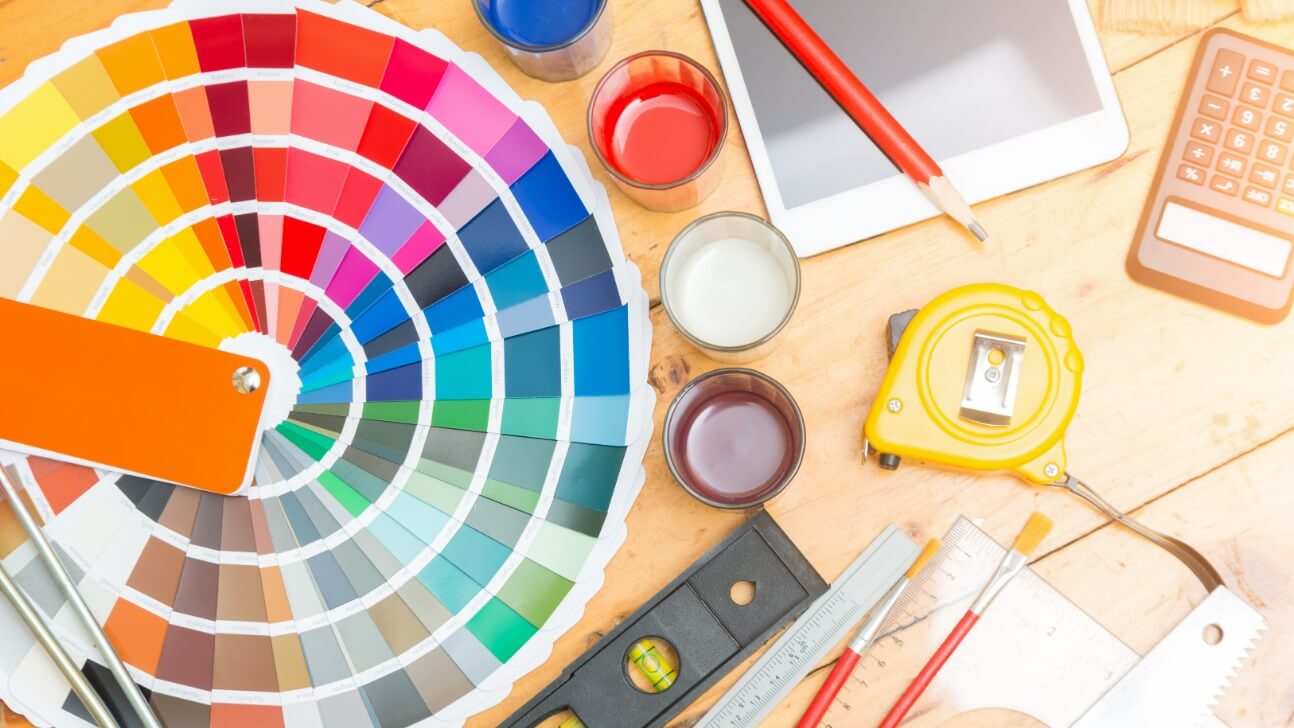Demystifying Color Theory for Painters: The Basics of Understanding Color Relationships
Summary

So you want to become a master painter. You're ready to create eye-catching works of art that stir emotion and make a statement. But first, you need to understand color theory. Color is the single most important element in painting—master it, and you’ll be well on your way to becoming the next Van Gogh or Monet.
What Is Color Theory?
Color theory is the study of how colors interact and relate to one another. Understanding it helps you use color more intentionally in your artwork.
The foundation of color theory is the color wheel, which shows the relationships between colors. Opposites on the wheel, like red and green, are complementary colors that create strong contrast and make each other stand out. Analogous colors—groups of hues side by side, such as red, red-orange, and orange—produce harmonious and cohesive palettes.
- Primary colors: red, blue, and yellow. The basis for all other colors.
- Secondary colors: orange, green, and purple. Created by mixing two primaries.
- Tertiary colors: formed by mixing a primary with a neighboring secondary, such as red-orange or blue-green.
Painters use the color wheel to build different harmonies:
- Complementary: Opposites like blue and orange—vibrant, high contrast.
- Analogous: Neighbors like blue, blue-green, and green—harmonious and calming.
- Triadic: Evenly spaced hues like red, yellow, and blue—balanced and lively.
Color theory provides structure and clarity for your creative choices. By mastering these basics, you’ll be able to design color schemes that evoke specific emotions and effects in your paintings.
The Basics of the Color Wheel for Painters
The color wheel is one of the most important tools for any painter. It illustrates relationships between hues and helps you design effective color schemes.
The Primary Colors
Red, blue, and yellow are the three primaries. They cannot be made by mixing other colors but serve as the building blocks of all others.
The Secondary Colors
Mixing two primaries creates secondary colors: orange (red + yellow), green (blue + yellow), and purple (red + blue). Blending a primary with a secondary yields transitional tones such as red-orange or blue-green.
Complementary Colors
Colors directly opposite each other on the wheel—such as blue and orange or red and green—are complementary. They produce striking contrast and energy when paired.
Analogous Colors
Analogous colors are side-by-side hues like blue, blue-green, and green. These combinations are naturally harmonious and soothing, ideal for backgrounds or unified themes.
Tertiary Colors
Tertiary colors, such as yellow-orange, red-purple, or blue-green, are made by blending a primary with an adjacent secondary. They add subtlety and depth to color transitions.
Using these relationships, you can craft monochromatic, complementary, split-complementary, triadic, or tetradic palettes to suit any mood or subject. With practice, the wheel becomes second nature, guiding your artistic choices with confidence.
Complementary Colors and Color Harmony
Complementary colors sit opposite each other on the wheel and generate high-contrast, vibrant pairings. Some classic examples include:
- Red and green
- Blue and orange
- Yellow and purple
When placed side by side, complementary hues intensify each other and command attention. To keep balance, distribute them thoughtfully in your composition. Too much contrast can overwhelm, while careful use adds drama and focus.
Harmony can also be achieved with analogous colors—adjacent hues such as blue, blue-green, and green. Combining complements with analogous tones creates vibrant yet balanced results. For instance, pair red, orange, and yellow with green, or blue, blue-green, and green with orange.
Another method is the split complementary scheme, where you use a color alongside the two hues flanking its opposite. For example, pair red with yellow-green and blue-green. This approach keeps strong contrast but softens the effect with added harmony.
Adjusting values and intensities further expands your options. Tints (lightened with white), shades (darkened with black), and tones (muted with gray) allow you to fine-tune mood and balance within a complementary scheme.
Experimenting with these relationships is one of the most exciting parts of painting. Over time, you’ll discover color harmonies that suit your personal style and subjects best.
Warm vs. Cool Colors
Colors can also be categorized by temperature. Warm colors—reds, oranges, and yellows—convey energy, vibrancy, and intimacy. They visually advance, making objects appear closer. Cool colors—blues, greens, and purples—evoke calm, serenity, and spaciousness, often receding into the background.
Tertiary Colors
Mixing a primary with a neighboring secondary creates tertiary hues such as red-orange, red-purple, blue-green, and yellow-green. These add nuance and versatility to your palette:
- Red-orange: vibrant and stimulating—great for energy and warmth.
- Red-purple: dramatic and luxurious—perfect for elegance.
- Blue-green: calming and natural—ideal for peaceful settings.
- Yellow-green: refreshing and lively—brightens cheerful spaces.
Complementary Colors
Opposites on the wheel, like red and green or blue and orange, deliver intensity and high contrast. Used in moderation, they create vibrancy without overwhelming the composition.
Whether warm or cool, bold or subtle, the choices you make with temperature, contrast, and intensity profoundly shape the mood of your work. With experimentation and practice, you’ll learn to manipulate color confidently to achieve any desired effect.
Monochromatic, Analogous, and Triadic Color Schemes
When it comes to color theory, understanding key relationships helps you plan palettes with confidence. Three foundational schemes are:
Monochromatic
A monochromatic scheme uses a single hue, varying only its tints, tones, and shades. This creates a calm, cohesive look. For example, explore a range of blues from pale sky to deep navy. To avoid flatness, introduce contrast in value (light vs. dark) and adjust saturation for visual interest.
Analogous
Analogous colors sit next to one another on the wheel (e.g., blue, blue‑green, green). They naturally harmonize and are an easy path to a unified painting. Choose one dominant hue and let the neighbors support it as accents. This approach is especially effective for serene, nature‑inspired scenes.
Triadic
A triadic scheme selects three hues evenly spaced on the wheel (e.g., red, yellow, blue). It’s vibrant and attention‑grabbing. To keep it balanced, reduce the saturation or value of one or two hues so one color leads and the others play supporting roles.
Other useful relationships include:
- Complementary: Opposites on the wheel (e.g., red and green). Delivers strong, high‑contrast pairings.
- Split complementary: A color plus the two hues flanking its complement (e.g., blue with yellow‑orange and red‑orange). Still vivid, but easier to balance than straight complements.
- Tetradic: Two complementary pairs (four hues). Powerful but challenging—anchor it with one dominant color.
- Accented neutral: A largely neutral palette (e.g., gray, taupe) punctuated with a bold accent (e.g., red or yellow) for a polished, modern feel.
With practice, these frameworks become second nature, giving you flexible options to match the mood and message of your work.
Color Value, Intensity, and Temperature
Three core properties shape how a color behaves: value, intensity, and temperature.
Value describes how light or dark a color is. High‑value colors are lighter (e.g., lemon yellow); low‑value colors are darker (e.g., navy). Strong value contrast adds depth and draws the eye to focal areas.
Intensity (saturation) indicates how vivid or muted a color appears. A highly saturated red feels bold and immediate; a grayed mauve feels subtle and restrained. Intensity sets the overall mood.
Temperature signals warmth or coolness. Warm hues (red, orange, yellow) tend to advance and energize; cool hues (blue, green, violet) recede and calm. Balancing temperature helps control spatial depth and emotional tone.
Consider how these attributes interact. For instance, a light, saturated version of a hue often reads warmer than a dark, muted version of the same hue. Thoughtful choices across value, intensity, and temperature create harmony and clear visual hierarchy.
A basic color wheel also maps relationships: complements (e.g., red/green, blue/orange) offer maximum contrast; analogous sets (e.g., red, red‑orange, orange) share temperature and can blend seamlessly; triads distribute contrast evenly around the wheel.
With practice, mixing and matching along these dimensions becomes intuitive, explaining why some combinations sing while others fall flat.
How to Use Color to Convey Mood and Emotion
How to Use Color to Convey Mood and Emotion
Color choices can shape a viewer’s emotional response. While context matters, certain associations are common and useful guides:
- Red: excitement, passion, warmth. Use for focal points and areas of emphasis.
- Blue: calm, tranquility, stability. Ideal for restful passages and expansive space.
- Yellow: optimism, light, cheer. A little goes a long way—use sparingly as a bright accent.
- Green: nature, growth, balance. Versatile for grounding a scene and conveying harmony.
- Orange: energy, creativity, sociability. Strategic accents can enliven a composition.
- Purple: luxury, imagination, mystery. Deeper purples feel dramatic; lighter tints feel whimsical.
- Black & white: clarity, contrast, timelessness. Add grays for subtle transitions and nuance.
Small shifts can significantly alter mood—try glazing to adjust intensity, or tweak temperature to push elements forward or back. Experiment, observe, and refine.
Understanding Color Relationships FAQ
Color theory explains how hues interact so your palettes feel intentional and cohesive. Here are quick answers to common questions:
What are complementary colors?
Complementary colors sit opposite on the wheel (e.g., red/green, blue/orange). Side‑by‑side, they boost each other’s intensity and create high contrast—great for emphasis.
What are analogous colors?
Analogous colors are neighbors on the wheel (e.g., blue, blue‑green, green). They blend smoothly, ideal for calm, unified passages or gradients.
What is the 60-30-10 rule?
A simple balancing guideline: use ~60% dominant color, ~30% secondary, and ~10% accent. It keeps variety without visual clutter.
What is value in terms of color?
Value is a color’s lightness or darkness. Purposeful value contrast guides the eye and defines form. Include a range of values for dynamic compositions.
How do I create color harmony?
Try these approaches:
- Use analogous or complementary pairings.
- Repeat key hues throughout the painting.
- Keep saturation and value relationships consistent.
- Limit the palette to 2–5 main colors.
- Apply the 60‑30‑10 guideline.
These strategies build cohesion and make your color decisions feel intentional.
Final Thoughts
You now have a practical toolkit for planning palettes and shaping mood. Explore complements, lean on analogous harmony, or go bold with triads—then fine‑tune value, intensity, and temperature to match your intent. The “rules” are guides; use them, bend them, and keep painting. With practice, choosing and mixing colors will feel effortless.
 by michael daigle
by michael daigle